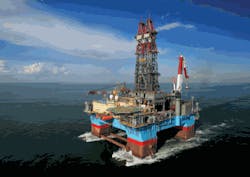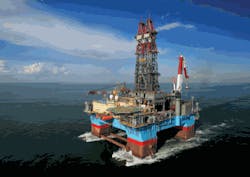Upstream News
ExxonMobil has confirmed two major oil discoveries and a gas discovery with a combined estimated recoverable resource of more than 700 million barrels of oil equivalent. The company made the discoveries in the deepwater Gulf of Mexico after drilling its first post-moratorium deepwater exploration well.
The KC919-3 wildcat well confirmed the presence of a second oil accumulation in Keathley Canyon block 919. The well encountered more than 475 feet of net oil pay and a minor amount of gas in predominantly Pliocene high-quality sandstone reservoirs. The well, being drilled deeper as of this printing, is located 250 miles southwest of New Orleans in approximately 7,000 feet of water.
Drilling in early 2010 encountered oil and natural gas at Hadrian North in KC919 and extending into KC918, with over 550 feet of net oil pay and a minor amount of gas in high-quality Pliocene and Upper Miocene sandstone reservoirs.
ExxonMobil encountered 200 feet of natural gas pay in Pliocene sandstone reservoirs at its Hadrian South prospect in Keathley Canyon block 964 during drilling in 2009.
"We estimate a recoverable resource of more than 700 million barrels of oil equivalent combined in our Keathley Canyon blocks," said Steve Greenlee, president of ExxonMobil Exploration Company. "This is one of the largest discoveries in the Gulf of Mexico in the last decade. More than 85% of the resource is oil with additional upside potential."
"We plan to work with our joint venture partners and other lessees in the area to determine the best way to safely develop these resources as rapidly as possible," Greenlee said.
ExxonMobil is the operator of KC918, KC919, KC963 and KC964 with 50% working interest. Eni Petroleum US LLC and Petrobras America Inc. each hold a 25% working interest in KC919, KC963 and KC964. Petrobras America Inc. holds a 50% working interest in KC918.
Noble Energy makes Santiago discovery in GOMNoble Energy Inc. has made a discovery at the Santiago exploration prospect in the deepwater Gulf of Mexico. The well, located in 6,500 feet of water on Mississippi Canyon Block 519, was drilled to a total depth of approximately 18,920 feet. Open-hole logging identified approximately 60 feet of oil pay in a high-quality Miocene reservoir. Noble Energy is the operator at Santiago with a 23.25% working interest.
Santiago is the third discovery in the company's Galapagos project, in addition to the prior successes at Santa Cruz and Isabela. Total gross resources discovered in the larger Galapagos project, including the Santiago well, are estimated by Noble Energy to be 130 million barrels of oil equivalent (MMboe). Approximately 75% of the discovered resources are oil.
Charles D. Davidson, Noble Energy's chairman and CEO, said, "The discovery at Santiago is a great way to resume our drilling program in the deepwater Gulf of Mexico. We expect all three wells at Galapagos to be online in early 2012, and we are increasing the project's total net production impact to Noble Energy to over ten thousand barrels of oil per day. This major project will deliver significant near-term production and cash flow for our business."
In late February 2011, the company received the industry's first drilling permit after the deepwater Gulf of Mexico moratorium for the Santiago prospect, where drilling was suspended in June 2010. Drilling operations resumed in early April 2011 following multiple reviews of operating and response plans, as well as third-party certifications of well designs and equipment.
Utilizing the Ensco 8501 drilling rig, the company will immediately proceed with completion operations at Santiago. Those operations are expected to last approximately two months, after which the company is planning to return to drilling the Deep Blue prospect (Green Canyon 723). Following Deep Blue, the company is planning to spud an appraisal well at the Gunflint discovery (Mississippi Canyon 948).
Other interest owners in the Santiago discovery are Houston Energy LP with 10%, Red Willow Offshore LLC with 20.25%, and BP Exploration & Production Inc., a wholly-owned subsidiary of BP America Inc., with the remaining 46.5%.
Shell to develop Cardamom field in GOMShell is pledging a multi-billion dollar investment to develop its Cardamom oil and gas field in the deep waters of the Gulf of Mexico. The Cardamom project is expected to produce 50,000 barrels of oil equivalent (boe) a day at peak production and more than 140 million boe over its lifetime.
The company's exploration plan for the Cardamom (Shell interest 100%) was the first to receive approval since the moratorium on drilling in the Gulf of Mexico was lifted. The company now plans to move ahead with further development drilling and installing undersea equipment.
Shell discovered the Cardamom reservoir in 2010 using advanced seismic technology that was able to produce improved images versus traditional seismic methods. The discovery was confirmed by drilling a well from Shell's Auger platform that broke records for length and depth. The exploration wells were drilled more than 6.4 kilometers (four miles) below the seabed.
Production from Cardamom will flow through the existing Auger platform.
The development of the Cardamom field is the latest step in Shell's deep-water energy production activities in the GoM. Perdido, the world's deepest offshore production facility, came on-stream in 2010. Later that year Shell announced the decision to go ahead with a second platform in our Mars B field in the GoM.
Apache makes Egypt discovery as Halyard Field produces first gasApache Corp. is on a roll as it recently announced discoveries in Egypt's Faghur Basin weeks after a subsidiary commenced gas and condensate production from its Halyard-1 discovery for delivery into the Western Australian domestic market.
Production from the Halyard-1 well, drilled in 2008 in production license WA-13-L, will be transported to market via an existing pipeline to the East Spar field facilities and from there to Apache's Varanus Island processing and transportation hub.
Development of the Spar field, located in adjacent License WA-4-R, is expected to follow in late 2012 as additional capacity becomes available at Varanus Island. The fields are both controlled from Apache's John Brookes platform. Apache's subsidiary owns a 55% interest in both WA-13-L and WA-4-R. Santos owns the remaining interests.
In Egypt, the company reported five new oil discoveries in its Faghur Basin play in the far southwest of Egypt's Western Desert oil and gas province.
Apache also said that the AG-96 development well in the Abu Gharadig Concession tested 3,347 barrels of oil and 1 million cubic feet (MMcf) of natural gas per day from the Lower Bahariya formation. The well – drilled on acreage acquired from BP in late 2010 – is expected to lead to several additional wells before year end, according to the company.
The Faghur Basin discoveries included:
- West Kalabsha-I-4 logged 79 feet of net pay in the Jurassic Safa sands. In a test, the well flowed 7,150 barrels of oil per day and 11.4 million cubic feet (MMcf) of gas per day.
- Faghur North-1X logged 25 feet of net pay in the Safa and Paleozoic Desouqy sands. Combined tests had a rate of 1,444 barrels of oil and 3.9 MMcf of gas per day.
- Faghur South-1X logged 38 feet of net pay in Safa and Cretaceous AEB-6 sands. The Safa tested 2,768 barrels of oil and 4 MMcf of gas per day.
- Huni-1X logged 27 feet of net pay in the AEB-3 sands. The well tested 970 barrels per day from the AEB-3E sand.
- Neith North-1X logged 20 feet of net pay in the AEB-3 sands and 57 feet of net pay in the Safa sands. A Safa well test is planned this month.
"The Faghur Basin continues to be a successful focus area for Apache, with AEB, Safa, and now Paleozoic reservoirs that have proven to be prolific oil and gas producers. These recent discoveries support the multi-pay potential of this oil-prone area of the Western Desert," said Tom Voytovich, vice president of Apache's Egypt Region. "The Huni and Neith North discoveries continue Apache's recent exploration success in the eastern area of the Faghur Basin.
Apache recently drilled the first discovery on its westernmost exploration concession. The Siwa-D-1X drilled in the Siwa Concession pushed Jurassic and Cretaceous plays farther south and westward and will lead to follow-up exploration prospects. Apache expects to commence production from the well upon approval of a development plan later in 2011.
The Tayim West-1X discovery in the West Kalabsha Concession represents the first Paleozoic success found in a reservoir separate from the younger proven Jurassic and Cretaceous sands and opens up the area to further deep tests in upcoming wells. The discovery is currently on production.
Thus far in 2011, Apache has drilled eight new discoveries in 10 attempts in the Faghur Basin, and drilling is under way on three additional wells –Mandulis-1X, Neilos-1X and Faghur North-2X. Eight additional exploration wells are planned for the area this year.
Apache continues to evaluate 3-D seismic surveys to identify additional exploration opportunities, including a recently completed 400-square-mile (1,040 square kilometers) survey across the Apache-operated Sallum Concession on the west side of the basin, and a 656-square-mile survey covering the eastern part of the basin underlying the Khalda Offset, South Umbarka and Shushan concessions.
Apache's current gross operated production in Egypt totals approximately 215,000 barrels of oil and 900 MMcf of gas per day, including 40,000 barrels of oil per day from the Faghur Basin.
More Oil & Gas Financial Journal Current Issue Articles
More Oil & Gas Financial Journal Archives Issue Articles
View Oil and Gas Articles on PennEnergy.com

